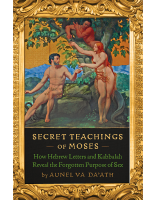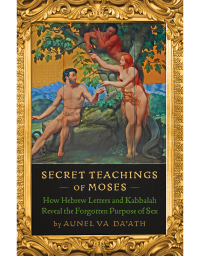The second alchemically world is Briah ריאה, the world of creation. Briah literally means “creation.”
So, first we have Atziluth אצילות, the world of archetypes, and then Briah, the world of creation. The book of Genesis is about Briah, creation; it esoterically details the way the universe and the earth were created. When we read about creation, we immediately have to place our attention in the second world, Briah.
Everything that is without form and void within the archetypical world (Atziluth) becomes shaped and formed in the world of Briah, the world of creation. This is due to the activity of Jehovah Elohim, which is the name of God in the Sephirah Binah in the world of Atziluth.
In the world of Atziluth, the name of the Sephirah Kether is “Eheieh Asher Eheieh” which in English means “He is what He is.” However, this is translated in Exodus 3:14 as “I am that I am,” when God was talking to Moses. Indeed, when God talks about himself he says “I am that I am.” But when we read it we should read “He is what He is” because we are not Kether. Kether is “I am that I am”: Eh-hei-eh Asher Eh-hei-eh.
The name of God in Chokmah, the second Sephirah in the world of Atziluth, is Jehovah. We always translate it as Jah-Havah, because it is masculine and feminine.
After Chokmah is the Sephirah Binah, whose holy name is Jah-Havah Elohim.
When we read in the Bible that Jah-Havah Elohim or Jehovah Elohim (or as it is translated, Jehovah God) created the universe, it is pointing to the Sephirah Binah, which in Christian terms receives the name of the Holy Spirit. Thus, Jah-Havah Elohim is Binah, the Holy Spirit in Christianity, or Shiva in Hinduism.
The first triangle in the Tree of Life is Father, Son, and Holy Spirit. That is the holy trinity which appears in every religion, but with different names, in accordance with the customs and nature of that religion.
Kether, Chokmah, and Binah are Hebrew words. In English they are Crown, Wisdom, and Understanding. In Christianity they are called Father, Son, and Holy Spirit. It is simple to understand: they are three forces in one, a tri-unity. In Hinduism, these three primary forces are Brahma, Vishnu, and Shiva. In various religions we will find different names for these three primary forces. In Gnosis they are referred to as the First, Second and Third Logos. In Greek, Logos means "word."
The second chapter of the book of Genesis tells us very clearly through its use of the names of God that the one who makes the universe is the Holy Spirit (Binah, the third Sephirah, whose name in Hebrew is Jehovah Elohim). The one who creates is the Holy Spirit.
The Holy Spirit in any organism relates to the sexual force, the sexual energy. God is energy, not a person. God as the Holy Spirit is the sexual force that we carry in our genitalia. In Gnosis, we place much emphasis and attention on the sexual energy because without it there is no creation (Briah, Genesis).
When we read that Jehovah Elohim—or Jah-Havah Elohim—created the universe, we understand that the sexual force of the Holy Spirit is the force that works in Briah: the world of creation.
Nevertheless, it must be stated that within the Holy Spirit are Kether (the Father) and Chokmah (the Son). These are three primary forces, three in one; in this same way, we intellectual animals possess three brains: the intellectual brain, the emotional brain, and the sexual/instinctual/motor brain.
Indeed, we are one person but with three brains; in this way we can understand the three primary forces in one. When we choose to multiply ourselves, we do not use our head (intellect) or heart (emotion), we use our sex. In the same way, if the three primary forces of the Trinity want to create, they do so through Jah-Havah Elohim, Binah, the Holy Spirit, Shiva, in the world of creation, Briah.
This is how we understand what is written in the first verses of the second chapter of the book of Genesis:
Thus the Heavens and the Earth were finished, and all the hosts of them. – Genesis 2:1
The "heavens" of Genesis represent the superior dimensions. The "earth" represents the inferior dimensions.
The word "heavens" is translated from the Hebrew word Shamayim שמים.
Shamayim begins with the Hebrew letter Shin ש, whose shape represents the three primary forces as fire. The very end of a trident—a fork with three points—has the shape of the letter Shin ש. This is the same fork with which Lucifer is depicted. This is because the three primary forces also work through him.
The letter Shin ש represents fire, and the word Mayim מים means water. So when we say Shamayim, we are saying Shin-mayim, “the fire within the water.” Thus, kabbalistically speaking, the heavens mentioned in the book of Genesis are the celestial fires working within the creative waters.
The water, Mayim מים, is related to the sexual libido. This is why in Alchemy we state that the sexual force is a liquid fire or fiery water, an igneous water. In our sexual libido—in our sexual seed—we have fire and water.
So when in the book of Genesis we read “heaven” within it is hidden the Hebrew word Shamayim שמים which implies the waters מים from above, within which Shin ש (fire) the three primary forces, are active.
In Sanskrit, those superior waters are called Akasha, which is a force or an energy—a blue substance in space which contains that fire. The Akashic waters are the waters from above, which in different religions are called the Mother, or Mother Space (like the Egyptian Goddess Nut), within which the heavens are contained.
Sequentially, in the book of Genesis it is stated that the heavens and the earth (Ha’Shamayim Ve Ha’aretz השמים והארץ) were finished. Ha’aretz הארץ, the earth, relates to matter.
There are many types of matter. The problem with the Western world is that people think that the only matter that exists is in the three dimensional world; the Bible however describes many types of matter, many “earths". When the Bible talks about “the earth,” in Hebrew it may be Ha’aretz הארץ, Adamah אדמה, or Epher עפר.
Adamah is "ground." Epher (“dust”) is the loose matter that takes shape in different levels; matter exists in different levels, in different dimensions. When we read “the heavens and the earth” we have to understand it is referring to the superior earth (matter), specifically in chapter two of the book of Genesis, because Ha’aretz or “the earth” is Mother Nature.
The heavens, Shamayim, are explained as the fire of the trinity within the superior Akashic waters. The earth is related to the dry land from the divided waters, the Mother under heaven.
And Elohim said, “Let the waters under the heaven be gathered together unto one place [the world of Briah], and [in order to create] let the dry land appear”: and it was so. —Genesis 1:9
This is why it is explained in chapter two of the book of Genesis:
These are the generations of the heavens and of the earth when they were created; in the day that Jehovah Elohim made the earth and the heavens. —Genesis 2:4
Again, Jehovah Elohim means the Holy Spirit. Jehovah Elohim is the Sephirah Binah in the world of Atziluth. In order for creation to occur, the Sephirah Binah (the Holy Spirit in Atziluth) descends into the world of Briah—the world of creation—and the Holy Spirit, Binah, divides itself into two polarities. Thus, the kabbalistic explanation of Jehovah Elohim's division is written:
...in the day that Jehovah Elohim made [divided itself into two] the earth [inferior forces] and the heavens [superior forces].
This is the division: heavens above, earth below. Man above, woman below. Abba (Father) above, Aima (Mother) below. This is the division of the two polarities of Binah.
Thus, this “earth” that we are talking about here is explained in the second chapter of the book of Genesis when it says:
And every plant of the field before it was in the earth, and every herb of the field before it grew: for Jehovah Elohim had not caused it to rain upon the earth, and there was not a man to till the ground. —Genesis 2:5
Genesis 2:4 states that the heavens and the earth were created. Thus, when you imagine the earth, you imagine it full of vegetation and life. But the fifth verse says “And every plant of the field before it was in the earth.” This means that the plants were not there. Therefore, this earth means the chaotic earth (matter) that is symbolized in the mysterious Sephirah Daath דעת (“knowledge”), where everything is possible.
And every herb of the field before it grew: for Jehovah Elohim had not caused it to rain upon the earth, and there was not a man to till the ground [Adamah אדמה]. —Genesis 2: 5
The ground (Adamah) is Ha’aretz, the earth. This means that the beginning of creation (Bereshith) is in the world of Daath, which is the expression of the first Eden.







